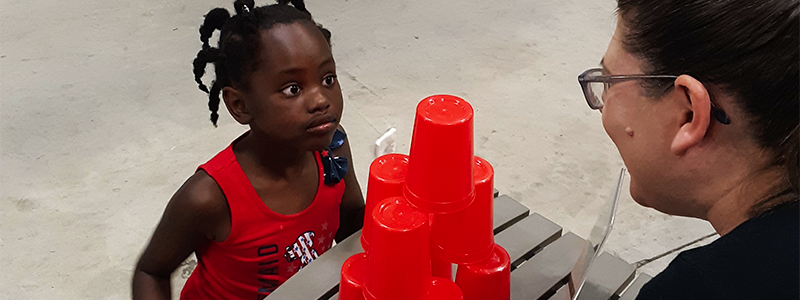 Eating and exercise habits are learned. Children aren't born knowing what is "good" for them. Children watch and do what their parents and siblings do. They want to eat what everyone else eats, and want to do what they see their family members doing. By helping children choose and learn to love healthy foods and exercise, parents provide the foundation for lifelong fitness.
Eating and exercise habits are learned. Children aren't born knowing what is "good" for them. Children watch and do what their parents and siblings do. They want to eat what everyone else eats, and want to do what they see their family members doing. By helping children choose and learn to love healthy foods and exercise, parents provide the foundation for lifelong fitness.
Start From Today
If your family is already eating the daily recommended portions of grains, vegetables, fruits, dairy, meats, and fats - congratulations! However, if yours is like most families, this isn't the case. Today's parents and families lead extremely busy and stressful lives that make it difficult for them to find the time to shop for, prepare, and eat several well-balanced meals everyday - let alone get in daily exercise.
The good news is that it's okay if you don't have perfect eating or fitness habits.
You can start today on a healthier lifestyle for your family. The key points to getting started are to:
- Make sure your family always has breakfast to start the day off right;
- Make one or two changes and gradually add to them;
- Make choices that work for your family's lifestyle; and
- Involve the entire family in the process.
It's an Epidemic: Obesity in Children at an All Time High
- Obesity, or being extremely overweight, is on the rise for children in the United Stat
- According to the Center for Disease Control, the number of children who are obese has more than tripled in the last 30 years.
- 1 out of every 5 children is overweight.
- Obesity can lead to serious health problems, including: Type 2 diabetes, heart disease (high cholesterol and high blood pressure), sleeping problems, asthma, and low self- esteem leading to depression.
- Once a child is obese, the chances are they will stay obese. Prevention is the key.
- Overeating is only one reason for weight gain; the most likely reason is inactivity or not moving enough. Activity is critical!
- All children 2 and older should participate in at least 30 minutes of fun, heart pumping activity every day.
- If your child is already overweight, seek the help of your family pediatrician who can determine the best weight for your child and provide guidance on nutrition and weight goals. Support your child by teaching him or her how to choose better foods and following healthy eating and physical activities at home.
The Basics of Healthy Eating
Healthy eating means choosing foods from all the food groups that will provide nutrients (vitamins, minerals, fiber) to your body. It also means making you're sure eating the recommended servings and portion sizes for your weight.
Family Time
Family mealtime is very important. Have mealtimes at regularly scheduled times whenever possible. Children respond well to predictable schedules and tend to snack less or overeat when meals are served regularly. Create a relaxed and unrushed atmosphere, have meals in the same location - the kitchen, dining room, or any room - where there are no distractions, such as a television. This will help the family to focus on the meal and on each other. Make eating a pleasant and fun experience where family can interact with each other, while learning to eat foods that are healthy for them.
You may not be able to have every meal together as a family, but designate at least one meal a day as a required family time. If your family's schedule doesn't permit this, eat together at few times a week.
What To Eat
First rule – There are no "bad" foods. You don't have to give up your favorite foods. Anything can be eaten in moderation. Eat a variety of foods, making sure you get a balance of recommended protein, fruit, vegetables, grains, and oils. The U.S. Department of Agriculture has a list of recommended daily requirements of food called the MyPlate.
How Much to Eat
Portion sizes are sometimes hard to figure out. One serving of a food item is sometimes in cups, ounces, teaspoons. The portions you get in restaurants are usually twice or triple the recommended amounts. For specific guidelines on serving sizes, visit the U.S. Department of Agriculture's Center for Nutrition Policy and Promotion, or ask your family physician.
What About Eating Out?
Most restaurants have children's menus, but they are frequently high fat, fried foods such as fried chicken, french fries, or grilled cheese, and not well balanced at all. Order from the regular menu for the children and make sure vegetables are part of the meal. If you have more than one child, a regular entree can be divided for smaller children to share. Most fast-food restaurants are adding salads and "healthier" options to their menu. When ordering from fast-food places, try some of the lower fat options such as baked potatoes (without the butter or sour cream) or grilled chicken salads and sandwiches (without the cheese or bacon).
Try this for family time:
- Decide which day(s) everyone can sit down together for a meal: Breakfast? Lunch? Dinner? Every day? Weekends?
- Make the most of family mealtimes:
- Talk about daily activities.
- Decide on what kind of activity the family will do later.
- Have a favorite food night when one person gets to choose one of their favorite foods to have as part of that meal.
Try this for what to eat:
- Make a standard grocery shopping list that has all the typical foods from each food group your family eats. Make several copies of it and take it with you, adding other items, every time you go grocery shopping.
- Make a list of your family's favorite foods: make recipe cards with them and substitute low fat or low sugar substitutes when possible.
- Get a low-fat or healthy cooking cookbook to try new recipes.
Try this for how much to eat:
- Keep a weekly log of what and how much your family eats. Even if everyone doesn't eat the recommended amounts every day, you can make sure that it is made up during the week.
- Make a chart of the food groups and make it a family routine for each member to check off the items they ate each day.
Healthy Eating for Children
Since children have smaller stomachs and eat less, it may make more sense for them to have 5 or 6 mini-meals throughout the day rather than 3 larger meals. For example, in the morning, your children may have cereal with low fat milk, and three hours later, have a banana and graham crackers with peanut butter, and then three hours later have an orange with carrots and glass of milk, and so on.
Helpful Tips
- Limit foods with sugar: candies, pastries, soft drinks.
- Try the 15 Rule: If your children doesn't like a food you serve, don't give up. Serve the same food up to 15 times over a time. Sometimes it just takes time for children to like something new.
- Make nutritious snacks for children: fresh fruit, cut up carrots, cereal with low fat milk, or dry cereal in a small baggie, graham crackers and low fat cheese.
- Give younger children smaller portions. If they want more, let them ask you.
- Don't expect a clean plate. That can lead to overeating.
- Don't use food to bargain or reward.
- Limit fat to 30% for each meal.
Let's Get Moving
If the goal is to be fit and healthy: eating a balanced diet and being physically active are the two main ingredients. They go hand-in-hand. Doing one, without doing the other will not help maintain good health. We talked about eating nutritious foods. Now, you gotta move.
Children do it naturally. They run, they wiggle, jump, crawl, climb, and skip. Young children are always on the go. This natural ability to be on the move is something that parents can build on when children are very young and help them continue to do throughout their lives. The first step is to make sure you are physically active too. Children are more likely to be want to be and stay active when other family members are active.
Try this:
- Start out with one or two things that your family can do everyday: household chores such as raking the yard, cleaning the bathroom, jumping rope, taking a walk, walking to the store instead of driving, playing in the yard or on the playground. Choose one and then build from there.
- Plan weekly family outings that involve outdoor activities: biking, swimming, hiking, tennis, Frisbee.
- Find activities or sports your children enjoy and can do outside of school: soccer, basketball, tennis, dancing.
- Let your infant roam around, safely, as much as possible - limit time in strollers and playpens.
- Immediately after school: have your children do a physical activity instead of doing homework right away.
- Make sure you are being active as well during the day - take the stairs as much as possible (when safe), bike instead of drive, go swimming, do a mall walk.
- Make staying fit fun for your family - use activity as a reward. (For example, take children bowling after doing chores for a week.)
For More Information
There is a variety of information for parents and families who want to eat better and get fit. Always ask your doctor or pediatrician about any new physical activities or nutritional programs to make sure all medical conditions or concerns are addressed. Check out these websites:
The Daily Parent is prepared by NACCRRA, the National Association of Child Care Resource and Referral Agencies.
© 2012 NACCRRA. All rights reserved.





